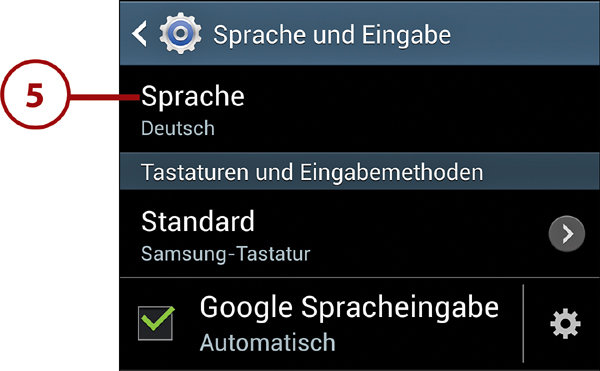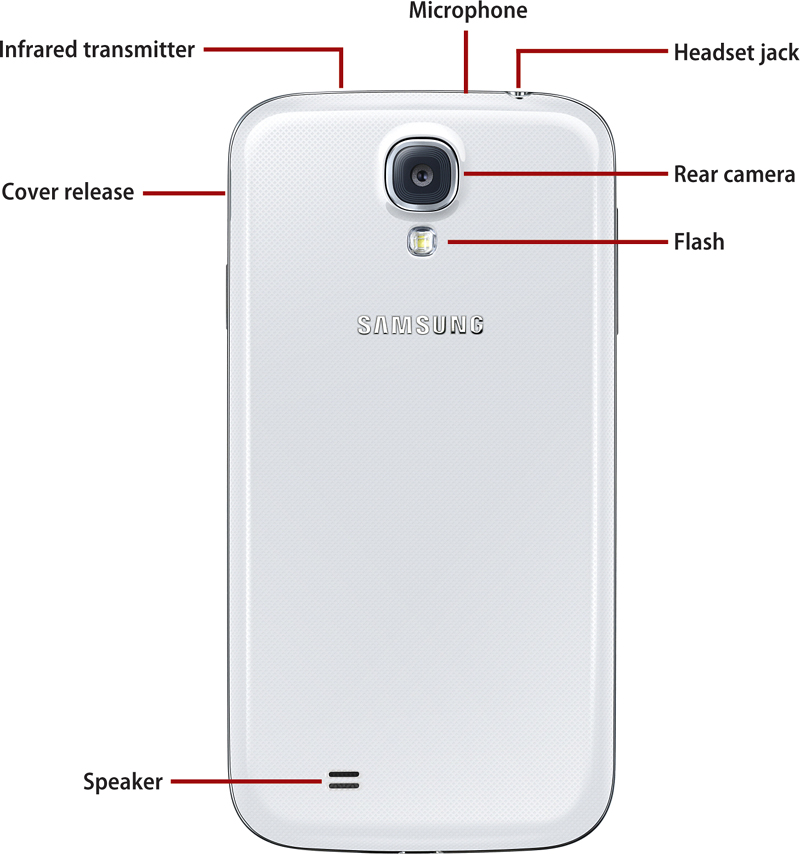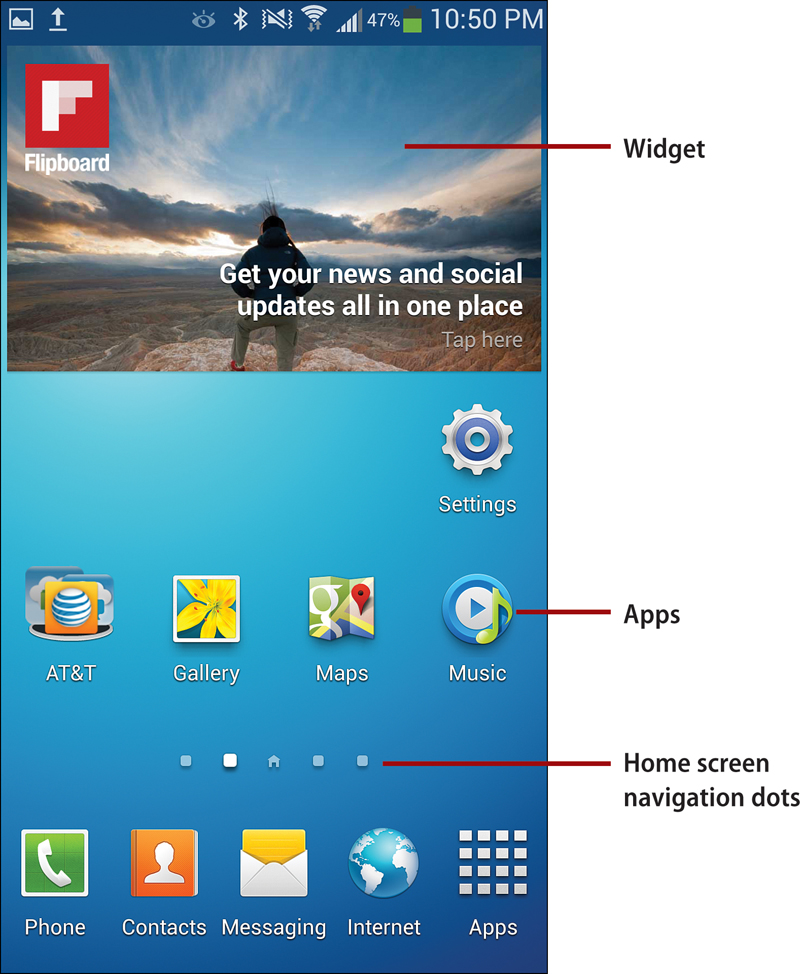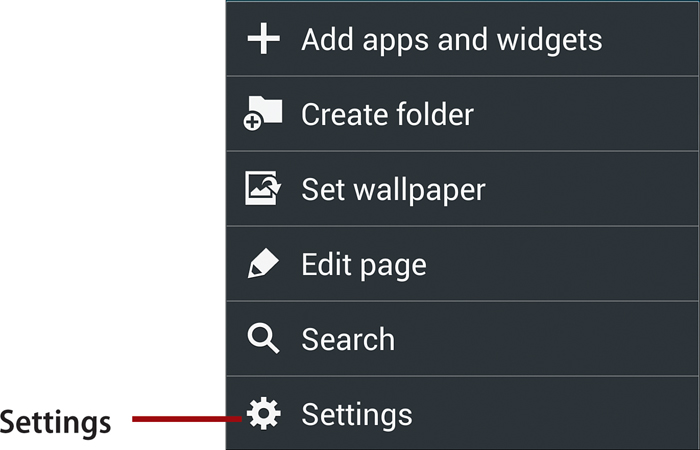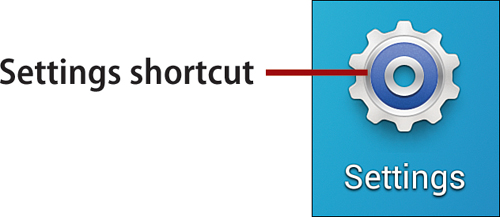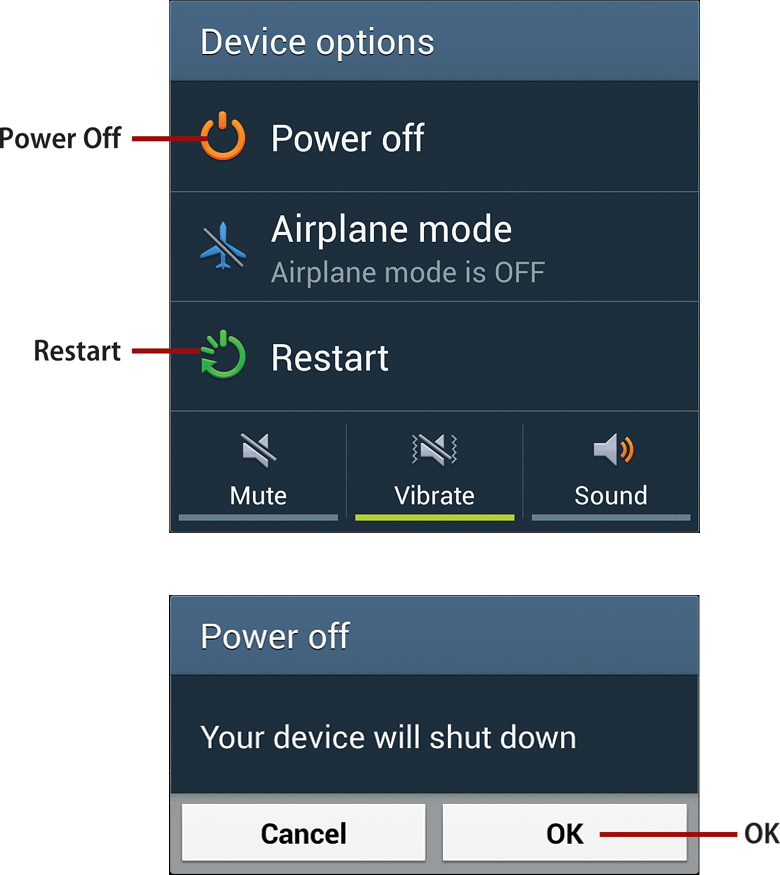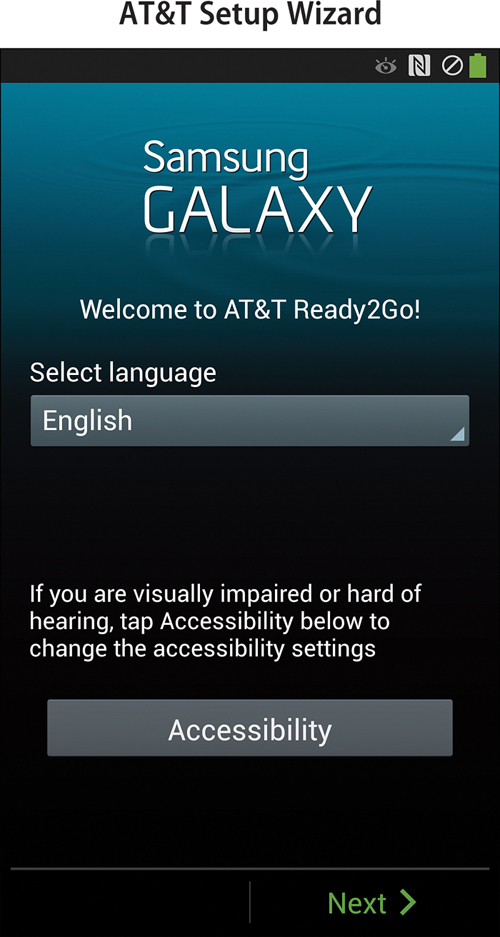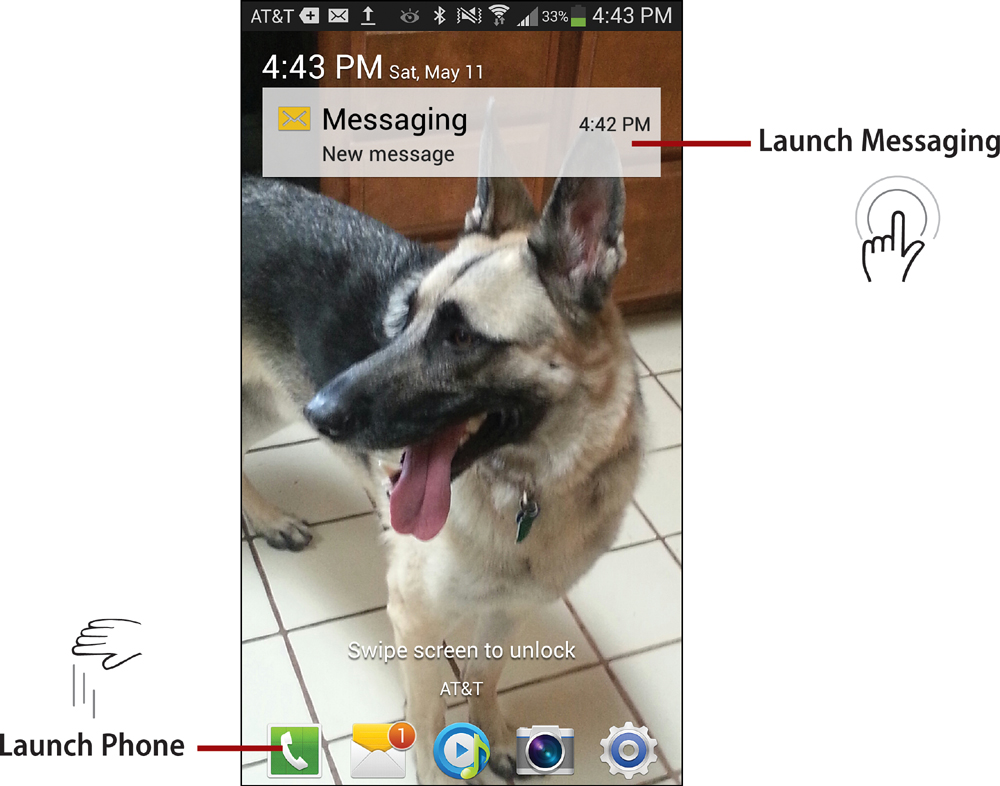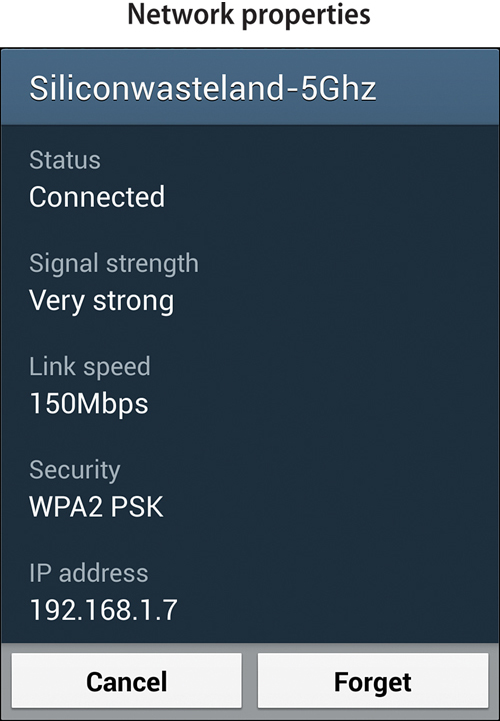1. Galaxy S 4 Essentials

In this chapter, you become familiar with the basics of setting up and operating your new phone. Topics include the following:
→ Familiarizing yourself with the phone hardware, operating system, interface, and customization options
→ Turning the phone on and off
→ Using a headset or headphones
→ Creating and registering a Gmail account
→ Connecting to a Wi-Fi network
→ Changing the phone’s default language
Welcome to My Samsung Galaxy S 4. In this chapter and Chapter 2, you become familiar with the fundamentals of operating and interacting with your new Android-based phone.
About the Galaxy S 4
As the latest entrant in Samsung’s all-star lineup of Galaxy S-series phones, the Galaxy S 4 is a fast, feature-laden smartphone. This section discusses the phone hardware, the Android operating system that powers the S4, the interface you use to interact with it, and available customization options.
The Hardware
To create a powerful, flexible smartphone, Samsung equipped the Galaxy S 4 with the following features:
• 1.9GHz quad-core processor, running the Android 4.2.x (Jelly Bean) operating system
• HD Super AMOLED, 1920 × 1080-pixel, 441 ppi, 5″ touchscreen display
• 2.0-megapixel front-facing camera; 13-megapixel rear-facing camera with 4x digital zoom and HD video recording
• 16, 32, or 64GB internal memory; 2GB RAM; and support for up to 64GB of additional memory with a microSDHC card
• 2.5G, 3G, and 4G/LTE network support
• Wi-Fi (802.11 a/b/g/n/ac), Bluetooth 4.0, and NFC connectivity
• GPS (global positioning system)
• IR (infrared) LED; MHL (Mobile High-definition Link) 2.0
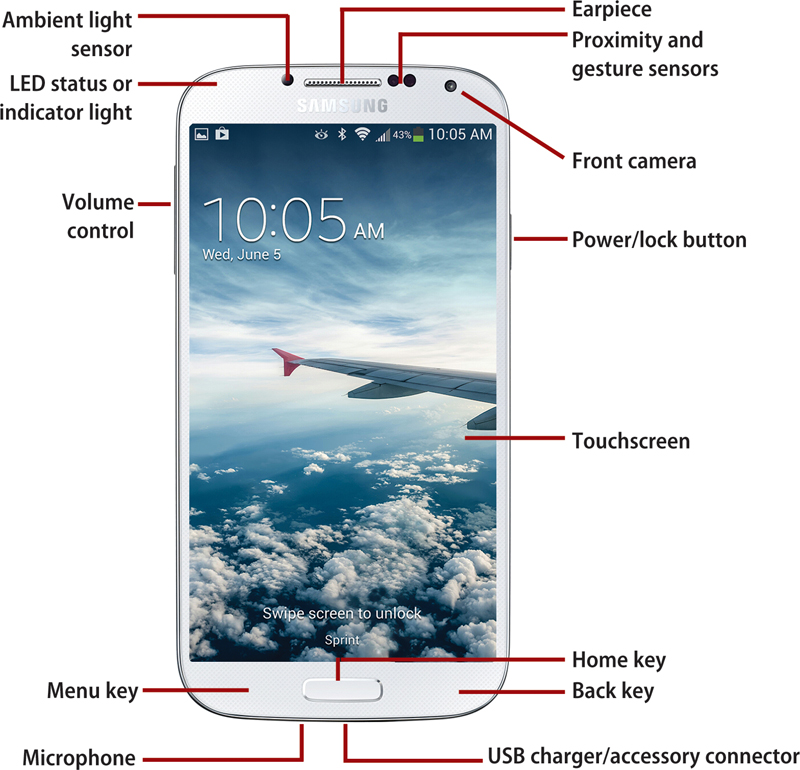
The following are the key hardware components of the Galaxy S 4:
Power/Lock button. Press the Power button to turn the phone on or off and to manually darken (lock) or restore the screen.
Volume control. Press this context-sensitive hardware control to raise (top part) or lower (bottom part) the volume of the current activity, such as conducting a call or playing music.
Microphones. Speak into the bottom microphone when participating in a call, giving voice commands, or using the phone’s speech-to-text feature. The top microphone is used for noise cancellation and stereo recording.
Earpiece. When you’re not using a headset, call audio is transmitted through this front speaker. The external speaker on the back of the phone is used to play music, ringtones, and other audio.
Headset jack. Port for connecting a compatible 3.5mm wired headset or headphones; enables 5.1 channel sound when playing media.
Front camera. Low-resolution (2-megapixel), front-facing camera for taking self-portraits and participating in video chats.
Rear camera. High-resolution (13-megapixel), rear-facing camera for taking pictures and high-definition movies.
Flash. Illuminates photos shot with the rear-facing camera (unless you’ve disabled it for the shot).
Touchscreen. Touch-sensitive screen; displays information and enables you to interact with the phone.
Menu, Home, and Back keys. Press these hardware keys to interact with the operating system and installed applications.
USB charger/accessory connector. Enables the phone to be connected with the supplied USB cable to a computer (for file transfers) or to the charger head and a wall outlet (to charge the phone’s battery).
LED Status or indicator light. Displays a flashing or steady light to indicate that the phone is performing its startup sequence, denoting notifications (such as newly received email or text messages), or showing the charging status.
Ambient light, proximity, and gesture sensors. The ambient light sensor enables the screen’s brightness to adjust to current lighting conditions. The proximity and gesture sensors detect how close an object is to the phone and whether particular gestures are occurring. During calls, the proximity sensor determines when your face is pressed to the screen and locks the keypad to prevent accidental key presses.
Adding a Memory Card
In addition to using the S 4’s built-in memory for storing email, photos, music, apps, and other material, you can purchase a memory card (up to 64 GB) to increase the phone’s available storage—much like adding a second hard disk to your computer. For information on installing, formatting, or removing a memory card, see “Viewing and Expanding Storage” in Chapter 19.
The Android Operating System and TouchWiz
Just like a computer, every smartphone has an operating system that controls virtually every important activity that the phone can perform, as well as the ways in which you interact with it. On the Galaxy S 4, the operating system is Android 4.2.x (Jelly Bean).
Like many of the other major cell phone manufacturers, Samsung has customized the Android operating system to differentiate its phones from those of competitors. Samsung’s TouchWiz touch interface is that operating system customization. Even though phones from other manufacturers run Android 4.2.x, TouchWiz ensures that Galaxy S 4 phones operate in a similar—but never identical—fashion to such phones.
Note that operating system updates are periodically made available to phones through the carriers.
The Interface
Much of what you do with the phone involves using its touchscreen. The Home screen consists of five customizable pages that you can optionally expand to seven. On it, you can place shortcuts to the applications (apps) that you use most often, as well as small applications called widgets that run directly on the Home screen. To interact with the touchscreen, you tap app icons to launch programs, flick up or down to scroll through lists, pinch and spread your fingers to change the current magnification, and so on. Chapter 2 explains in detail how to work with the touchscreen interface.
Easy or Standard Mode
If you’re new to cell phones (or just to Android phones), you can elect to use a Home screen variant called Easy Mode. Although the material in this book is based on Standard Mode, you may want to use Easy Mode until you’re comfortable with the phone. See “Setting the Home Screen Mode” in Chapter 2 for instructions and information about switching modes.
Customization
One of the main reasons for buying a smartphone such as the Galaxy S 4 is that you can do considerably more with it than you can with an ordinary telephone or cell phone. Much as you can do with a computer, you can customize your phone by populating the Home screen with custom arrangements of widgets and application icons, change the Home and lock screens’ background (wallpaper), install additional useful applications, and set preferences (settings) for the system software and installed applications. When you’re comfortable with the phone’s basic operations and are ready to start customizing it, read Chapter 3.
Charging the Battery
The Galaxy S 4 includes a two-piece wall charger that consists of a special USB cable and a charger head. You charge the phone’s battery by connecting the assembled wall charger to the phone and a standard wall outlet. It’s recommended that you fully charge the phone before its first use.
It isn’t necessary to wait until the battery is almost fully discharged before charging. In fact, the phone’s manual recommends that you not wait because repeatedly letting the battery completely drain can reduce its capability to store a charge.
Connecting to a Computer
The battery also charges while the phone is connected to a computer by the USB cable. See “Transferring Files over USB” in Chapter 15 for instructions on making the connection.
1. Plug the large end of the USB cable into the charger head.
2. Plug the small end of the USB cable into the bottom of the phone.
3. Plug the charger head into a wall outlet. The LED indicator light glows while the phone charges.
4. When the LED changes color and the indicator shows 100%, the phone is fully charged. Disconnect the USB cable from the wall outlet and phone.
Charging While the Phone Is On
If you need to complete a call or use apps when the battery is almost drained, you can continue to use the phone while it charges.
Powering On/Off
Although many people prefer to simply leave their phones on, you can turn yours off whenever you like—to conserve the battery, for example.
• To turn on the phone, press and hold the Power button until the phone vibrates and begins its normal startup sequence (approximately 4 seconds).
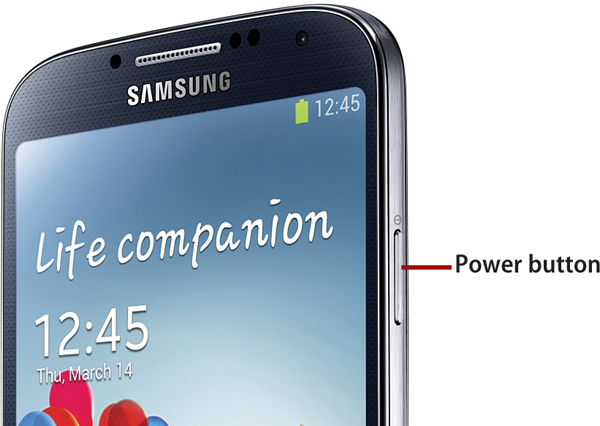
• To turn off the phone, press and hold the Power button for 1–2 seconds. In the Device Options menu that appears, tap Power Off. Tap OK in the Power Off dialog box to confirm that you want to shut down your phone.
Restarting the Phone
You can also restart the phone from the Device Options dialog box. If you’ve been running the phone continuously for several days, periodically restarting clears memory fragmentation—enabling you to start again with a clean slate.
Darkening and Restoring the Display
Depending on your screen timeout setting, the display automatically turns off during periods of inactivity. In addition to waiting for this timeout to occur, you can manually darken the display to conserve the battery or maintain privacy by pressing the Power button on the right side of the phone.
Restoring a Dark Display
1. Press the Power button on the right side of the phone to make the lock screen appear. (The lock screen also appears when you turn on the phone.)
Dimmed, Not Dark
The display automatically dims for a brief period before it turns black. To restore a dimmed display, tap any blank spot on the touchscreen.
2. Swipe in any direction to dismiss the lock screen.
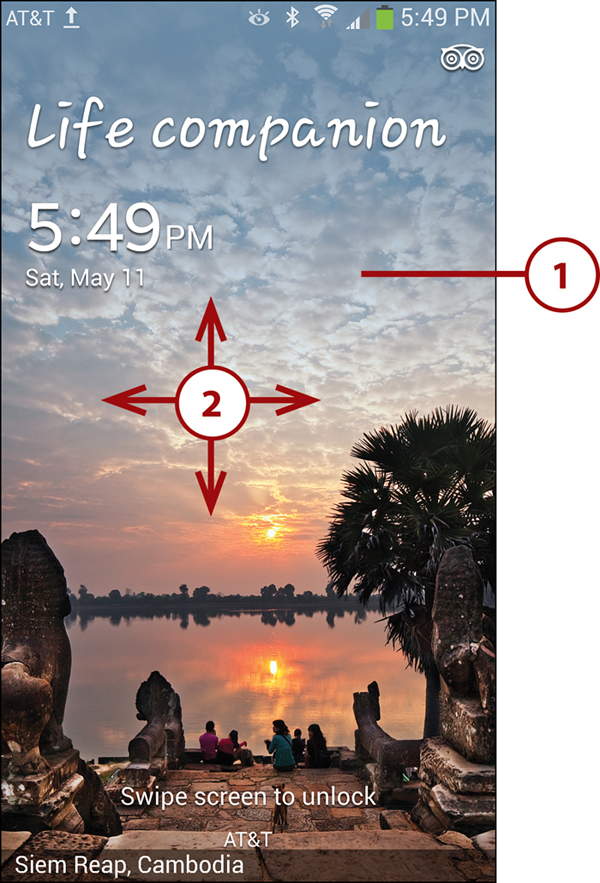
Working with a Locked Phone
You can secure the phone by assigning a password, PIN, or pattern, for example, to require more than a simple finger swipe to dismiss the lock screen. See “Securing the Lock Screen” in Chapter 17 for instructions.
Setting the Screen Timeout Interval
1. On the Home screen, tap Apps, followed by Settings.
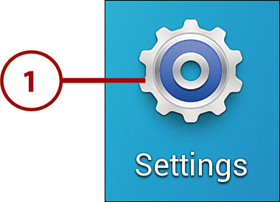
2. Select the My Device tab.
3. Tap Display.
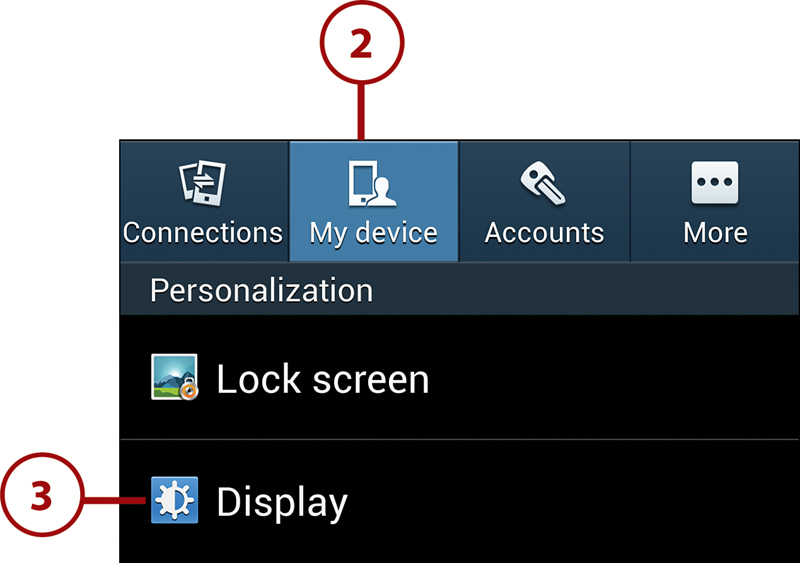

5. In the Screen Timeout dialog box, select a new timeout interval or tap the Cancel button to retain the current setting.
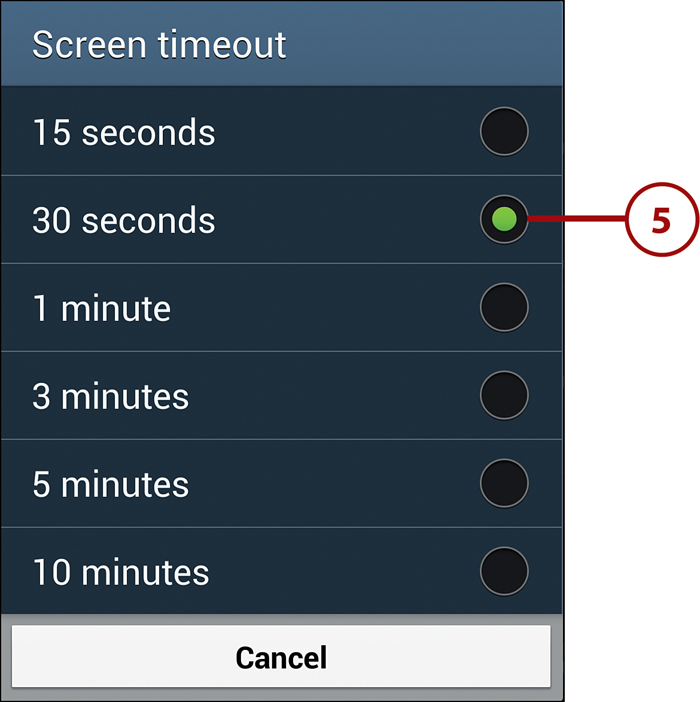
It’s All About Trade-Offs
Substantial juice is needed to power the phone’s gorgeous display, so the sooner it dims during idle periods, the longer the current charge will last. The key is to select a screen timeout that enables the phone to sit idle as long as possible before dimming and still have sufficient charge to meet your daily calling and app requirements.
To avoid timeouts when you’re reading or viewing material onscreen, enable the Smart Stay setting. (In Settings, select the My Device tab, scroll down and tap Smart Screen, and ensure that Smart Stay is checked.) If the front-facing camera detects that you’re looking at the screen, it prevents the normal timeout from occurring.
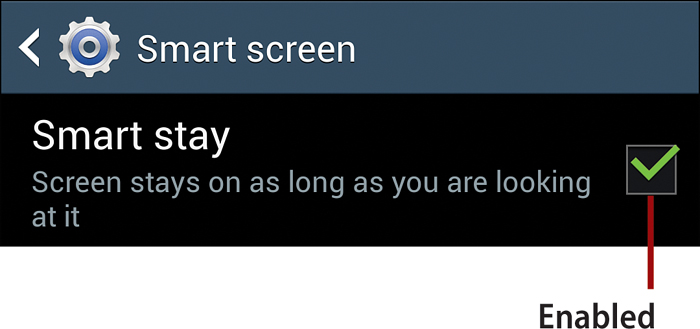
Adjusting the Volume
You can press the volume control on the left side of the phone to adjust voice volume during a call, media playback volume, or ringer volume (when you’re neither playing media nor participating in a call). The volume control is context-sensitive instead of being a general volume control; what is affected when you press the control depends on what you’re doing.
1. To change the volume, press the volume control on the left side of the phone. A context-sensitive control appears.
2. To raise or lower the volume, drag the slider. You can also press the top part of the hardware volume control to raise the volume or press the bottom part to lower the volume.
3. Optional: To adjust other common volume settings, tap the Settings icon and drag the sliders that appear.
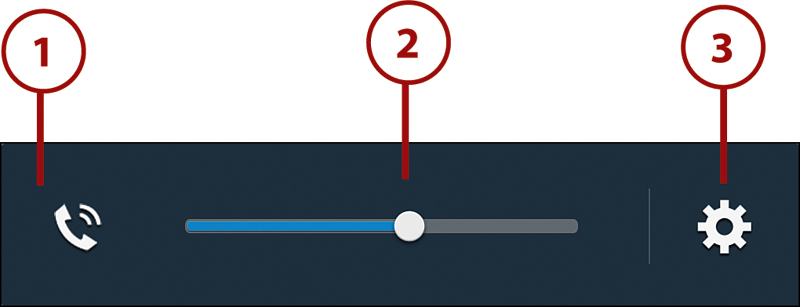
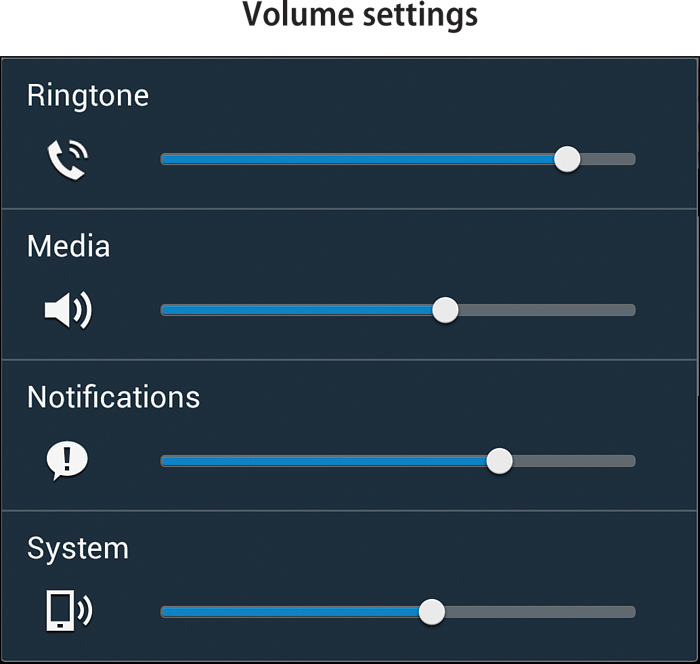
Adjust Everything at Once
You can also open Settings to adjust the various volumes. On the Home screen, press the Menu key, and—in order—tap Settings, My Device tab, Sound, and Volume. Adjust the volume sliders by dragging and tap OK.
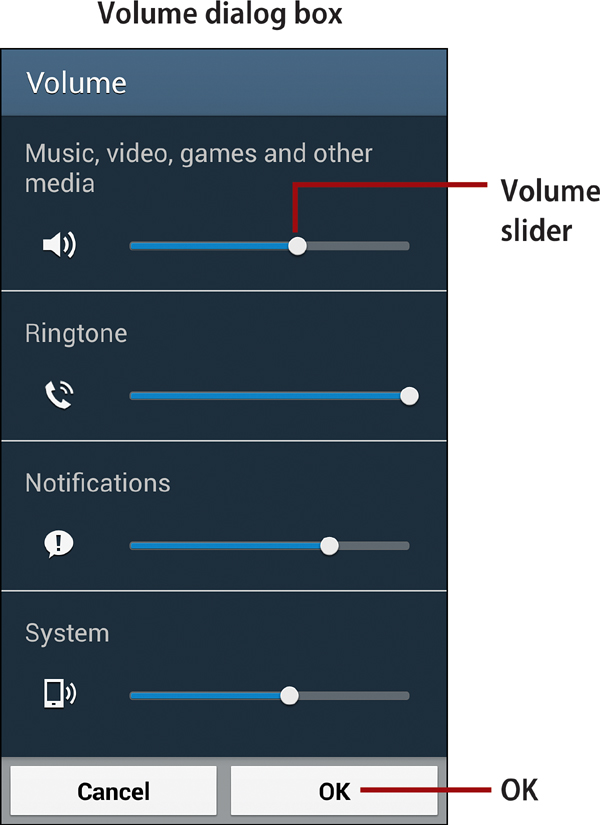
Using a Headset or Headphones
By connecting the headset that’s included with the Galaxy S 4 (or any other compatible 3.5mm wired headset or headphones), you can improve the phone’s audio quality. For example, the Music app supports 5.1 channel sound when a headset is connected. And a wired or a wireless (Bluetooth) headset is handy for making hands-free calls.
Using a Wired Headset or Headphones
1. Plug any compatible headset or headphones into the jack at the top of the phone.
2. Adjust the volume for whatever you’re currently doing (taking a call, playing media, and so on) using the phone’s or the headset’s volume control. For instructions on the former, see “Adjusting the Volume,” earlier in this chapter.
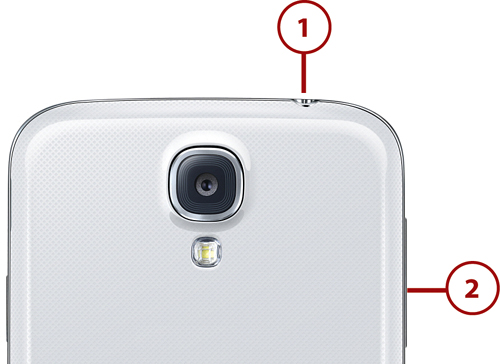
Using a Bluetooth Headset
Although a few Bluetooth headsets support stereo (making them suitable for listening to music), most are mono devices intended primarily for hands-free phone calls. With a maximum range of 30 feet, using a Bluetooth headset enables you to place the phone nearby and conduct a conversation. Unlike using a speakerphone, the audio is routed directly to your ear and the headset’s microphone won’t pick up as much ambient noise.
Working with a Bluetooth headset involves two steps: pairing the headset and phone (a one-time procedure) and using the headset for calls. The procedures for pairing and answering calls are specific to your headset and are explained in the headset’s instructions. As an example, the following tasks illustrate how to use a Jabra EasyGo Bluetooth headset with the Galaxy S 4.
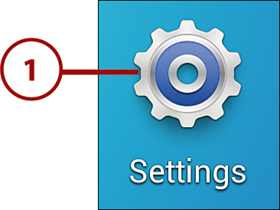
2. Select the Connections tab at the top of the screen.
3. In the Network Connections section, enable Bluetooth by dragging the slider to the On position, turn the Bluetooth headset on, and then tap Bluetooth.
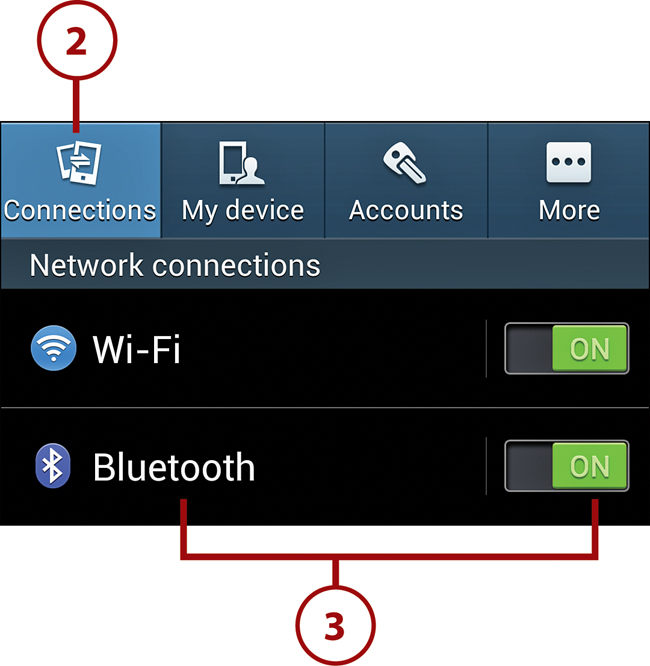
Check Your Headset’s Manual
Your Bluetooth headset may require more than simply turning it on to enter pairing mode. The Jabra EasyGo, for example, can be paired with two devices. You must hold down the Answer button for 5 seconds to initiate the second pairing.
4. Optional: If the headset doesn’t appear in the Available Devices list, tap the Scan button.
5. Tap the headset’s name to pair it with the phone.
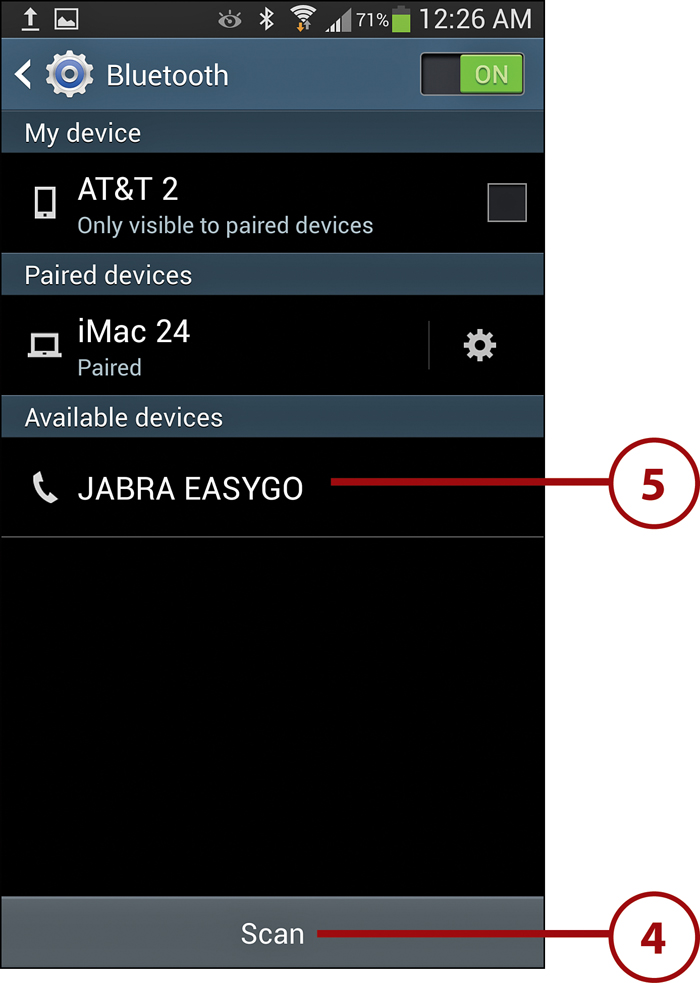
6. A confirmation appears when pairing is successful.
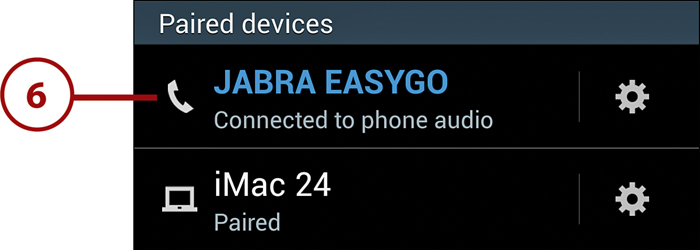
Using the Headset for Calls
1. Turn on the headset and place it in your ear. If Bluetooth isn’t currently enabled, open the Notification panel by dragging the status bar downward. Tap the Bluetooth icon to enable it.

When the Headset Won’t Connect
If a previously paired Bluetooth headset refuses to connect to the phone, open the Notification panel, and then disable and re-enable Bluetooth.
2. To place a call, dial using any of the methods supported by the phone (see “Placing Calls” in Chapter 4).
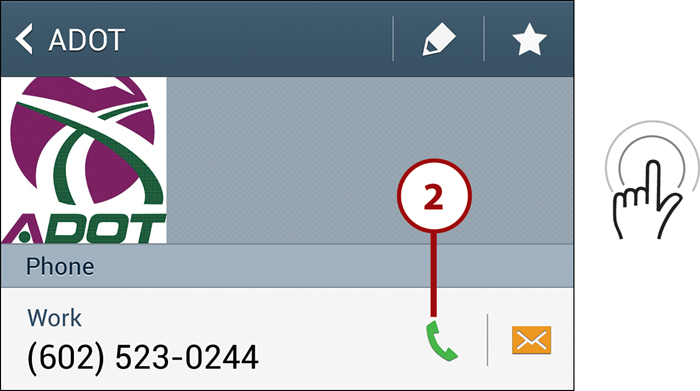
3. To receive an incoming call, tap the headset’s Answer/End button or drag the green Accept Call icon to the right.
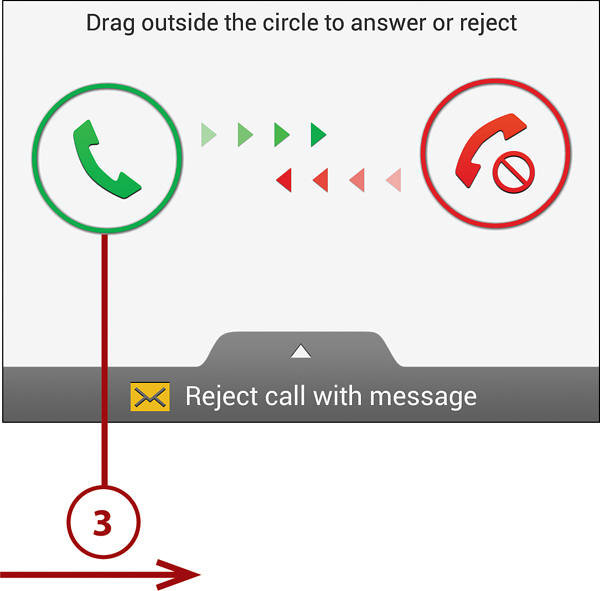
Adjusting the Volume
While on a call, you can adjust the volume by pressing the volume control on the left side of the phone or on the headset.
4. To end the call, tap the headset’s Answer/End button or tap the End Call icon on the phone. When you finish using the headset, you can remove it from your ear and turn it off.
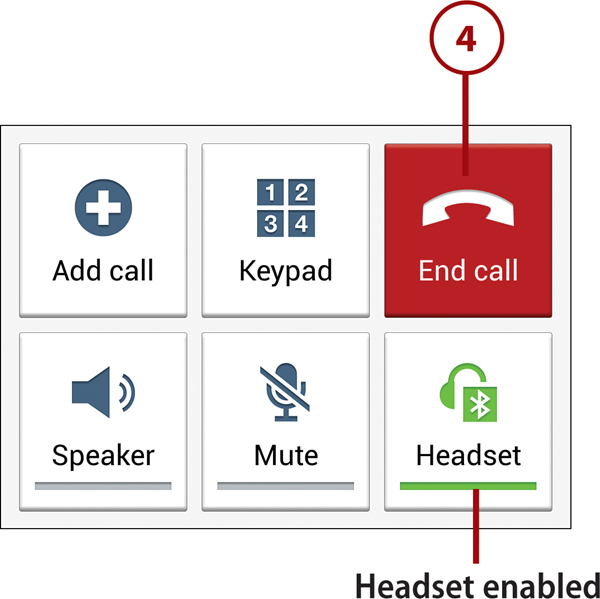
Setting Up Voicemail
After your phone is activated, one of the first things you should do is set up voicemail. Doing so identifies the phone number as yours and ensures that callers have an opportunity to leave a message when you’re unavailable.
Note that the exact process of setting up and using voicemail is specific to each provider. Providers may even include their own app that you can use to review and manage your voicemail. (See “Using Voicemail” in Chapter 4 for instructions on accessing voicemail and changing your settings.)
1. On any Home screen page, tap the Phone icon.
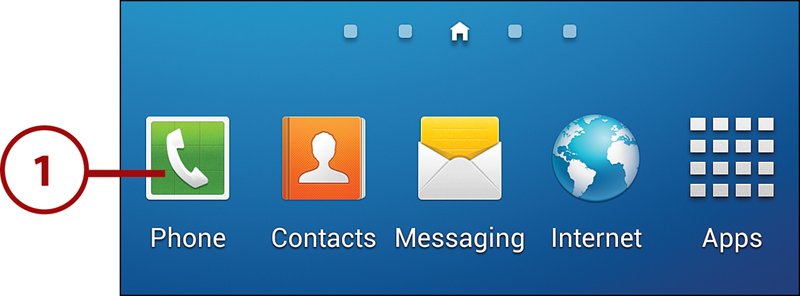
2. On the Phone keypad, press and hold 1 (the speed dial number reserved for voicemail) or tap the Voicemail icon.
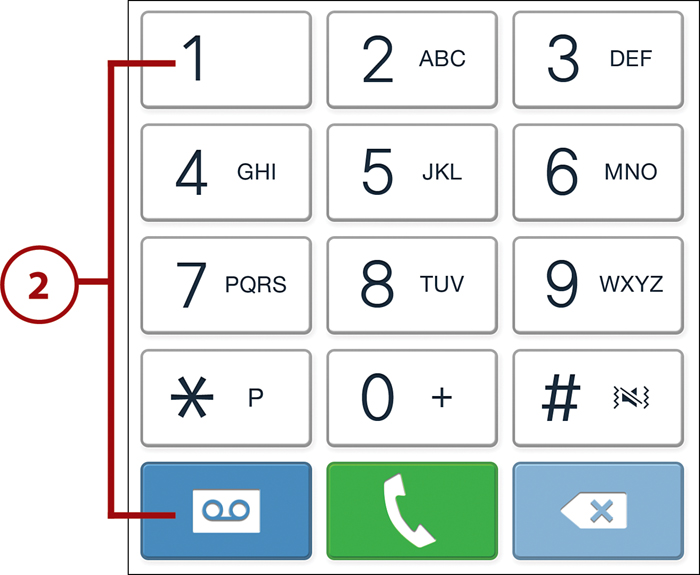
3. When prompted, record your name, enter a password, and select or record a greeting. When you finish reviewing voicemail options, tap the End Call icon.

Gmail and Your Phone
Your phone runs on Android, the Google operating system. To use and connect to any Google service (such as Google Play, the source for Android apps that run on your phone), you must have a Gmail account—Google’s free email service. If you don’t have an account, you should create one now. The final step is letting your phone know your Gmail account username and password, enabling it to access Google services.
Do It the Easy Way
Although you can create a Gmail account using your phone, a lot of typing is required. It’s easier to use your computer’s web browser (as described next). On the other hand, if you don’t have access to a computer or would prefer to create the account using your phone, go to Settings; select the Accounts tab; and tap Add Account, Google, and New.
Creating a Gmail Account
1. On your PC or Mac, launch your web browser: Internet Explorer, Safari, Firefox, or Chrome, for example. Type www.gmail.com in the address box and press Enter/Return.

2. Click the Create an Account button in the page’s upper-right corner.

3. Enter the requested registration information on the Create a New Google Account page.
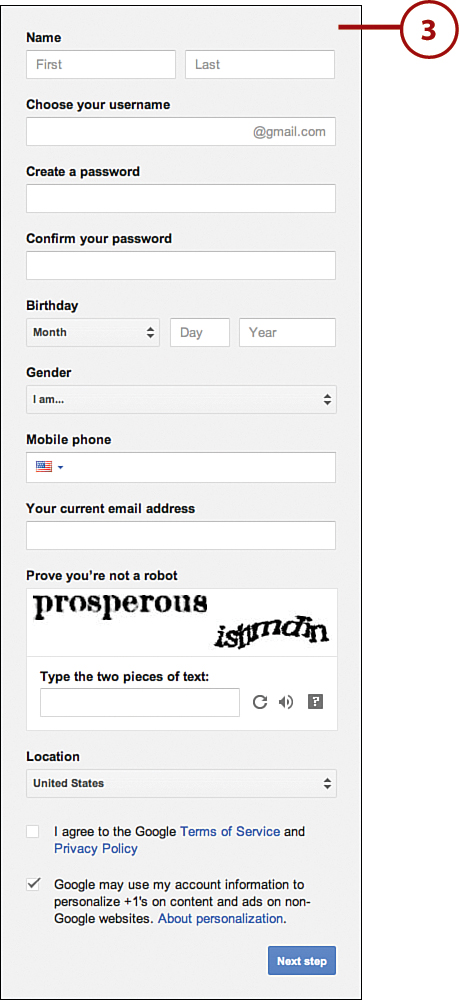
Registering Your Gmail Account
If you just created a Gmail account using your computer’s browser, you need to add the account to your phone. (To see if the account is already registered, open Settings and select the Accounts tab. If Google is listed in the My Accounts section, the account is registered, and you can skip the following task.)
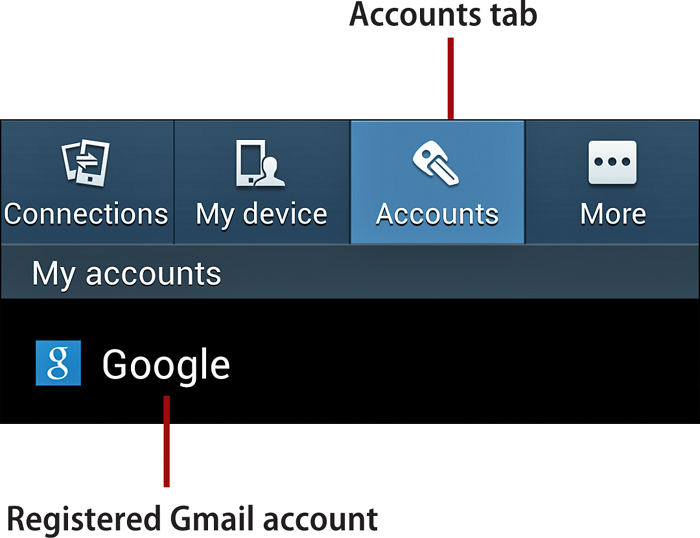
1. On the phone’s Home screen, tap the Apps icon.
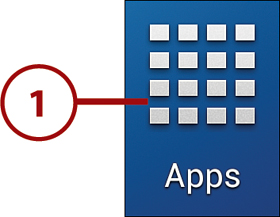
2. Tap the Gmail icon.

3. On the Add a Google Account screen, tap Existing. (If you don’t have a Google/Gmail account, tap New and follow the onscreen prompts, or perform the steps in “Creating a Gmail Account.”)
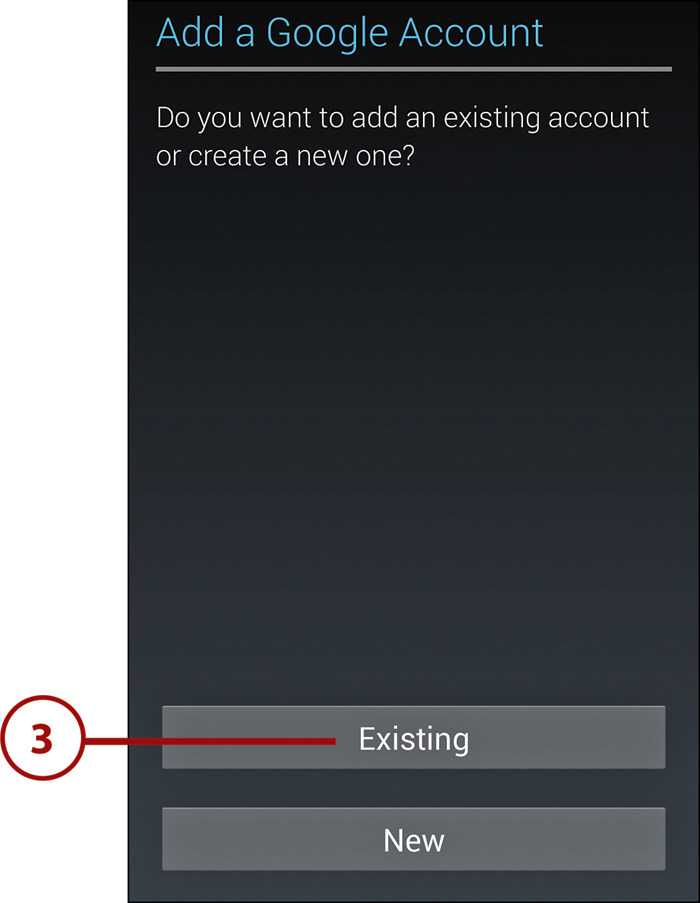
4. Enter your Gmail username and password. Tap the right-arrow icon to continue.
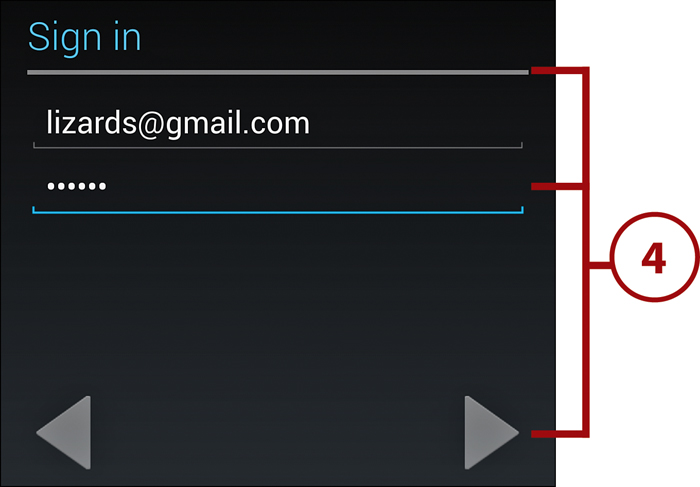
5. Click OK to agree to the Terms of Service.
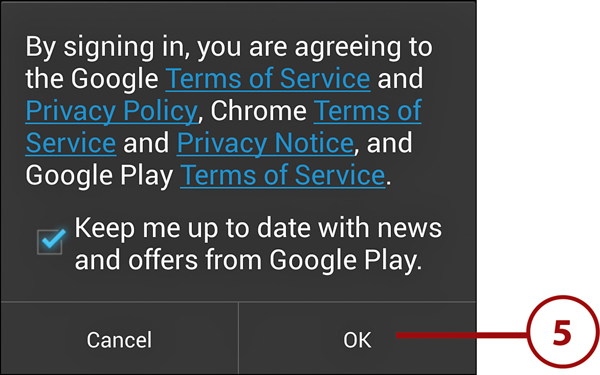
6. On the Backup and Restore screen, the check box determines whether important phone data will be routinely backed up to your Gmail account. Ensure that the box is checked or unchecked according to your preference, and then tap the right-arrow icon.
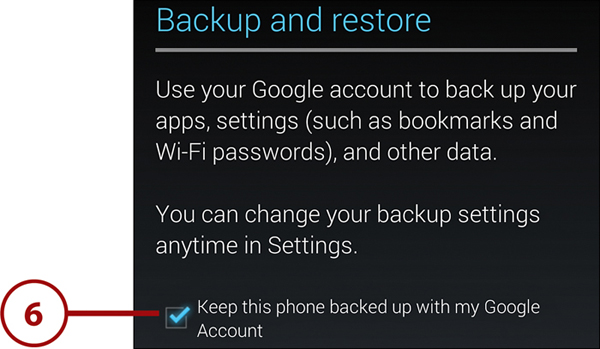
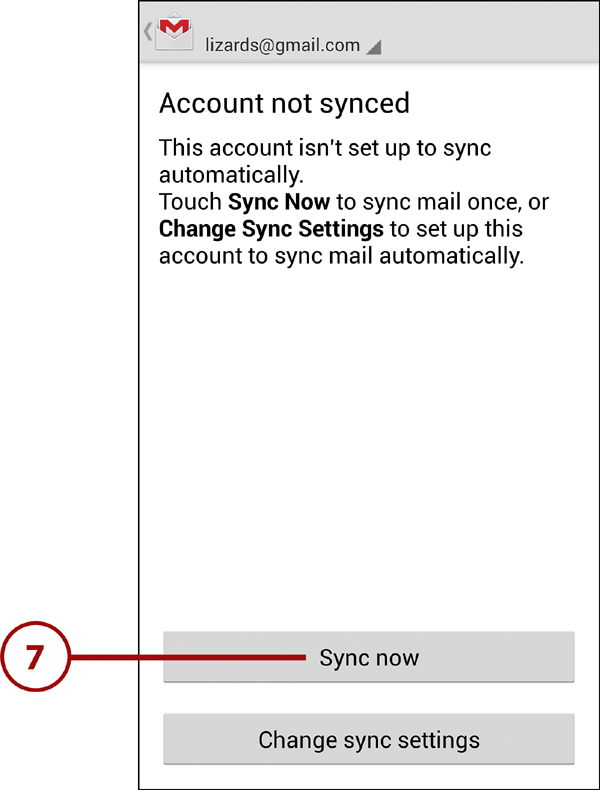
8. A sync is performed and your Gmail account’s Inbox displays. Press the Home key when you want to exit from Gmail.

Creating a Samsung Account
Certain Samsung applications that are supported on the Galaxy S 4, such as ChatON, Music Hub, and SamsungDive, require you to sign up for a free Samsung account. If you didn’t create the account or log into an existing one when you ran the setup wizard, you can create the account now—or the first time you use an application that requires it.
1. On the Home screen, tap Apps, followed by Settings.
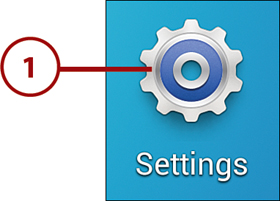
2. Select the Accounts tab and tap Add Account.
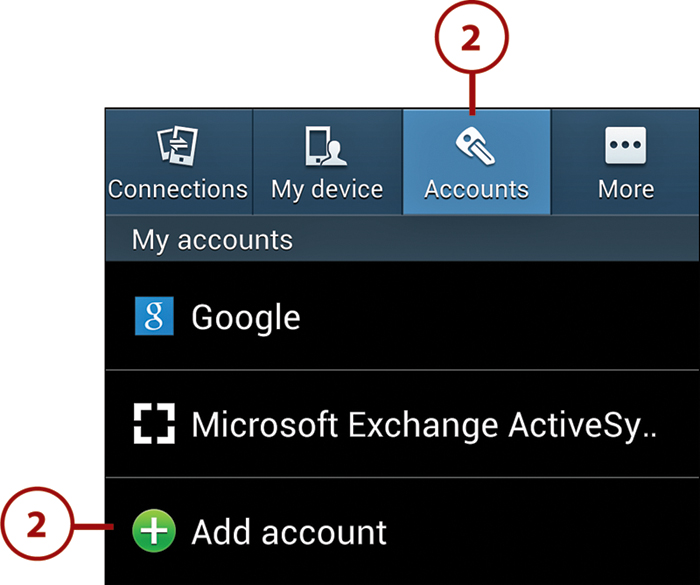
3. Tap Samsung Account. (If the account’s dot is green, you’ve already added a Samsung account to this phone and can skip the remaining steps.)
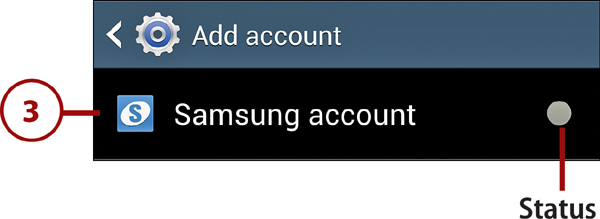
4. Tap Create New Account.
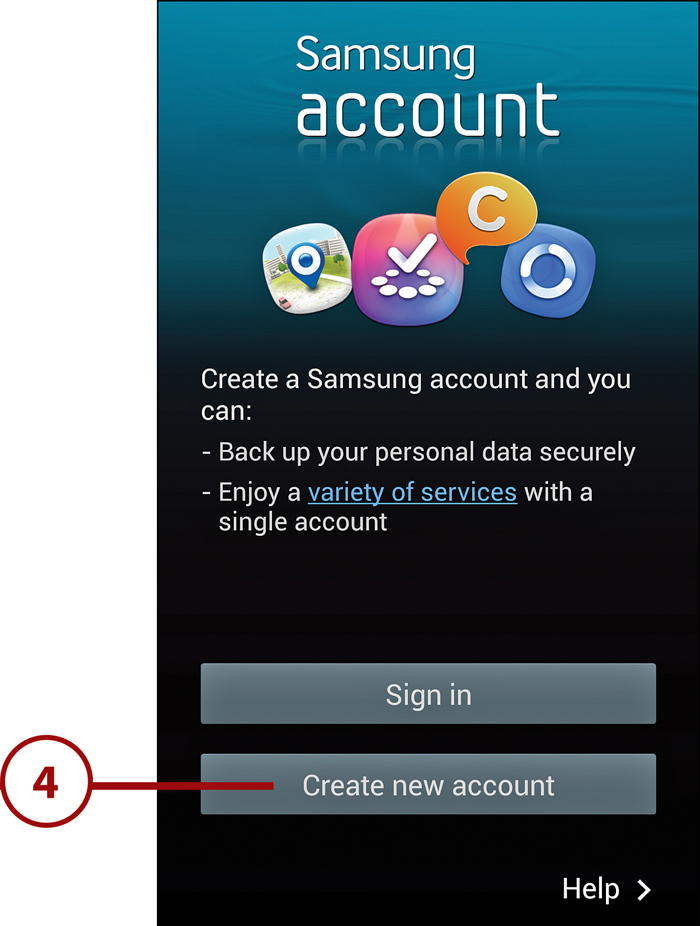
5. Create the account by entering an email address and password to use for the account, as well as the other requested information. Scroll to see the additional fields. Tap the Sign Up button.
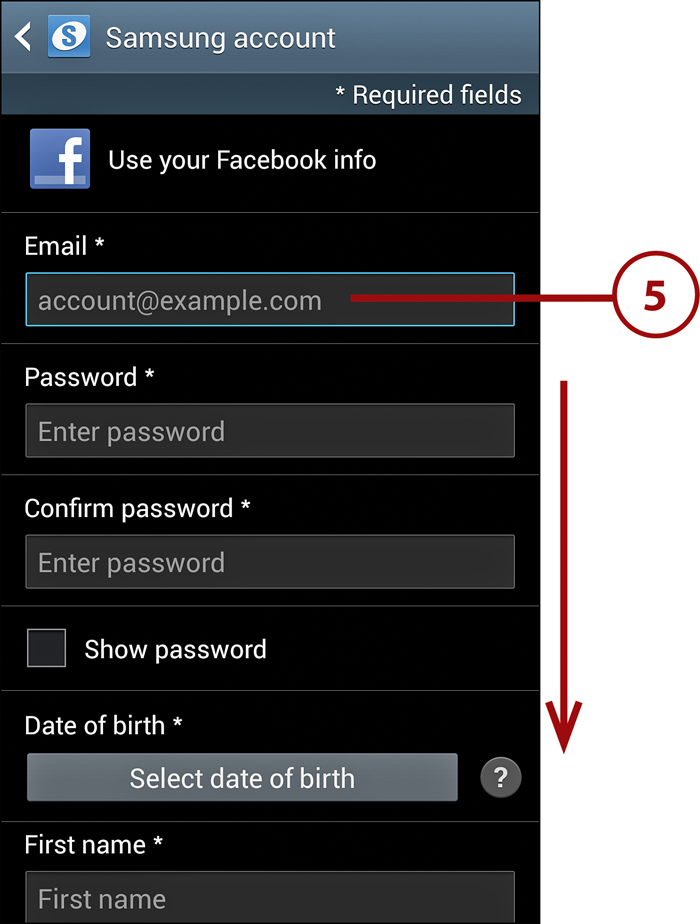
6. Review the Terms and Conditions, tap I Accept All the Terms Above, and then tap the Agree button.
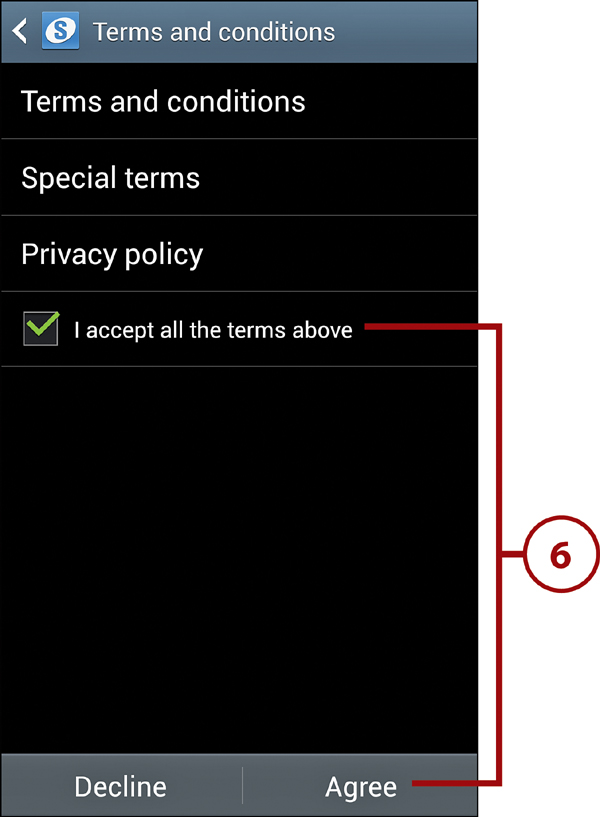
7. Open the account verification email message on your phone or computer and follow the account activation instructions. When you finish, the Samsung account is marked with a green dot on the Add Account screen, indicating that it’s recorded on your phone.
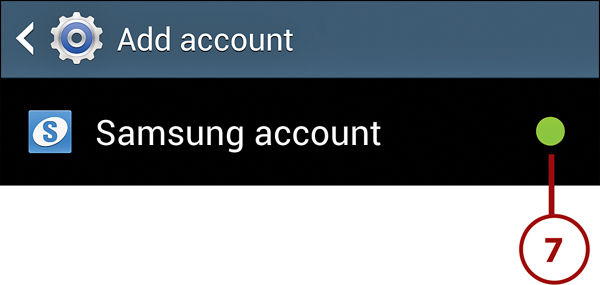
Placing and Receiving Calls
Although Chapter 4 covers placing and receiving phone calls in detail, here’s a quick summary of the process. For other outgoing call options, such as calling someone with a Contacts record, see Chapter 4.
Placing a Call
1. Tap the Phone icon at the bottom of any Home screen page.
2. Using the onscreen keypad, enter the number to dial.
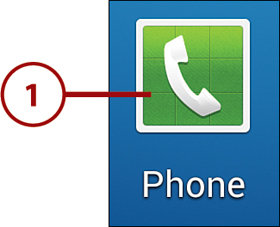
Country Code and Area Code Prefixes
When calling a number outside of your cell phone’s area code, be sure to enter the recipient’s area code. It’s only necessary to enter a country code, such as 1 for the United States and Canada, when you’re dialing a country that uses a different code than yours.
3. Tap the green phone icon to dial the call.
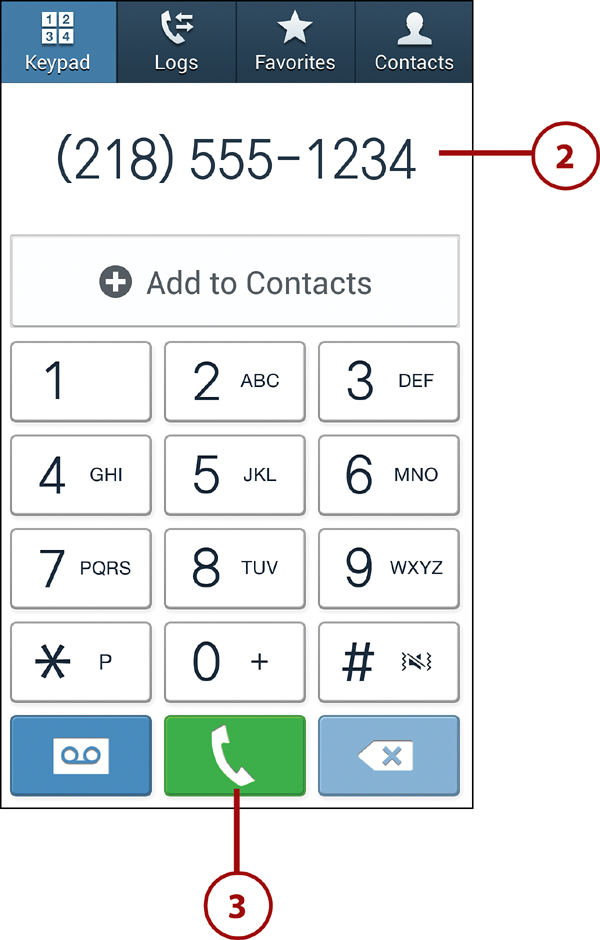
Receiving a Call
1. When a call is received, the caller is identified by name and number (if he has a Contacts record), by number (if there’s no matching Contacts record), or by Private Caller (if the caller has blocked caller ID).
2. Do one of the following:
• To accept the call, drag the green phone icon in any direction.
• To reject the call and send it to voicemail, drag the red phone icon in any direction.
• To reject the call by sending a text message of explanation, drag the Reject Call with Message tab upward and select a message to transmit.
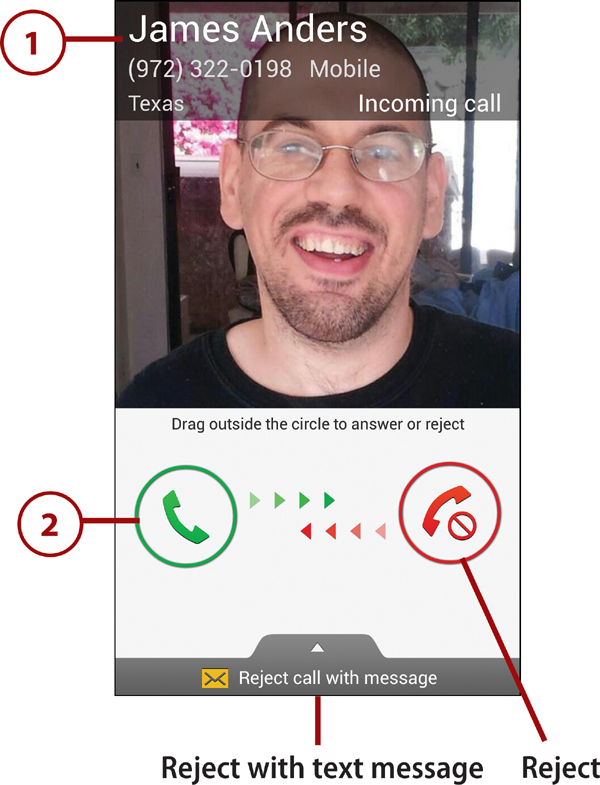
3. When the call is completed, tap End Call.
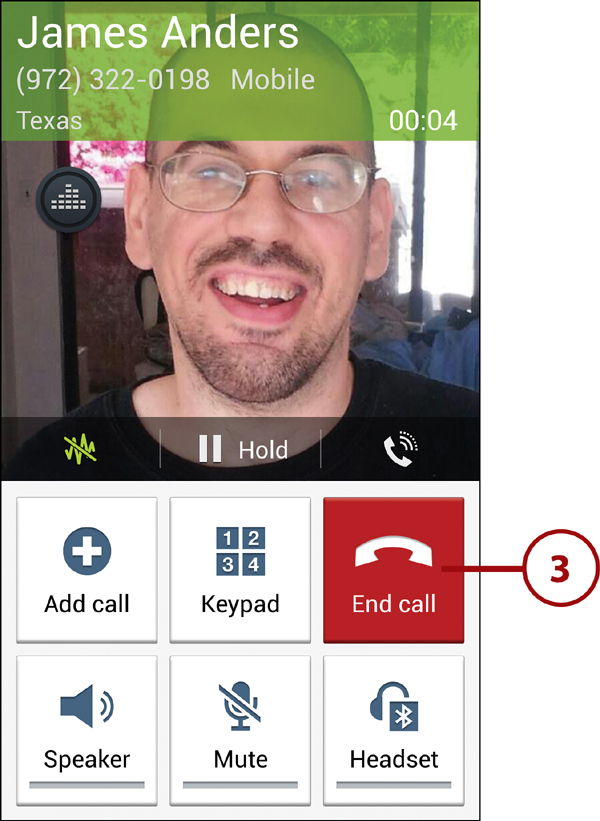
Working with Data
Any activity that transmits data to and from your phone over the cellular network counts toward your plan’s data limit. The same data transmitted over Wi-Fi, on the other hand, doesn’t count. By tapping icons in the Notification panel, you can manually control the method by which data transmissions occur, ensuring that the least expensive and fastest method is used. In this section, you learn how to enable and disable Wi-Fi, as well as how to connect your phone to a wireless (Wi-Fi) network.
Connection Methods
At any given time, only Wi-Fi or 2G/3G/4G can be the active data connection method. When Wi-Fi is enabled and you’re connected to a network, 2G/3G/4G is automatically disabled. When Wi-Fi is disabled or unavailable and you perform a data-related activity, 2G, 3G, or 4G is automatically used (depending on what’s available at your current location).
You can also use Bluetooth to exchange data directly between the phone and any Bluetooth-capable computer or laptop. For instructions on using Bluetooth for data transfers, see Chapter 15.
Manually Setting a Connection Method
1. Open the Notification panel by touching the status bar at the top of the screen and dragging downward.
2. The Wi-Fi icon toggles between a Wi-Fi and cellular (2G/3G/4G) data connection. Wi-Fi is enabled when the icon is green; a cellular connection is active when the Wi-Fi icon is dim. Tap the Wi-Fi icon to toggle its state.
3. Close the Notification panel by touching the bottom of the panel and dragging upward.
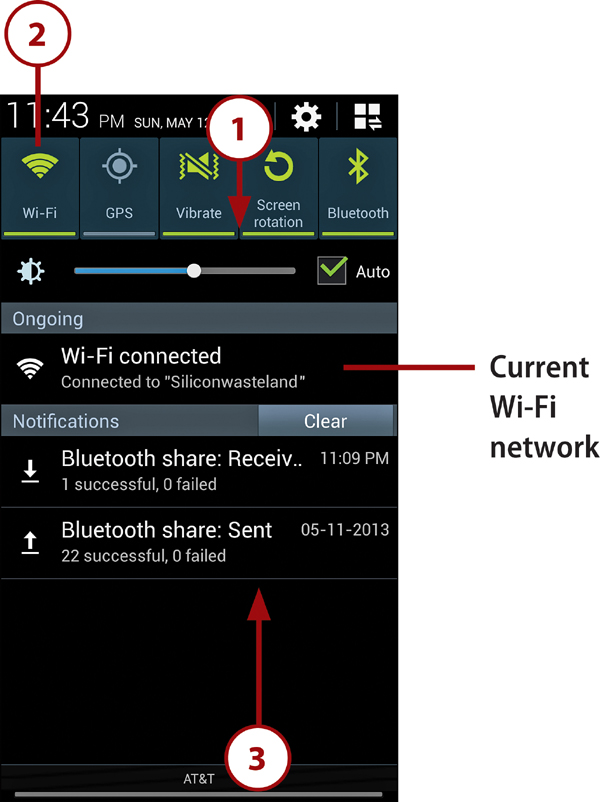
Which Wi-Fi Network?
When you enable Wi-Fi, a notification in the Ongoing section of the Notification panel shows the network to which you’re connected.
Monitoring Data Usage
If your data plan isn’t unlimited, you can use the Data Usage setting to monitor your usage and warn when you’re close to the limit. See “Managing Talk Time and Data Usage” in Chapter 19 for details.
Connecting to a New Wireless Network
Because it’s free and often a faster connection than using a 2G, 3G, or 4G cellular connection, it’s advantageous to use a Wi-Fi connection whenever it’s available. After you successfully connect to a given network (such as your home network or one at a local coffee shop), your phone can reconnect without requesting the password again.
1. On the Home screen, tap Apps, followed by Settings.
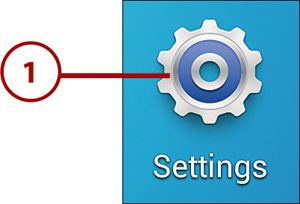
2. Selection the Connections tab.
3. Enable Wi-Fi (if it’s off) by dragging its slider to the On position and then tap the Wi-Fi text.
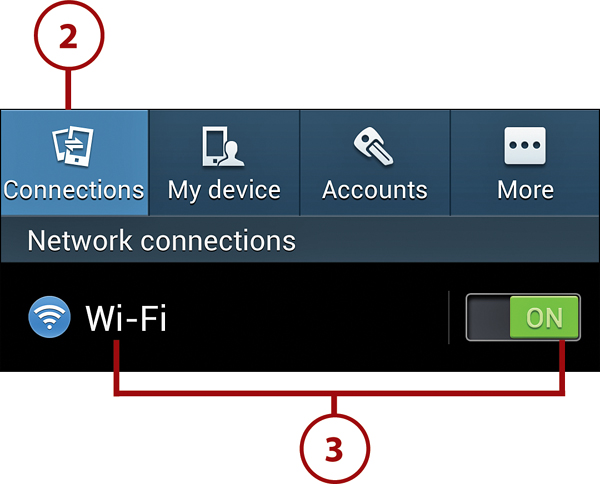
4. A list of nearby networks appears. If a network to which you’ve previously connected is found, the phone automatically connects to it. If no network is automatically chosen or you want to connect to a different network, tap the name of the network to which you want to connect.
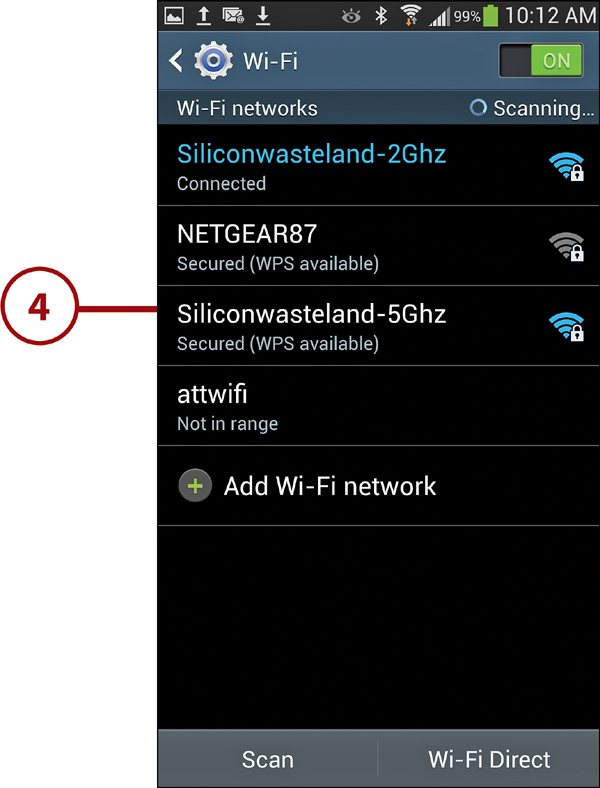
• If the network is unsecured (open), tap the Connect button.
• If the network is secured (password protected), enter the requested password, and then tap the Connect button.
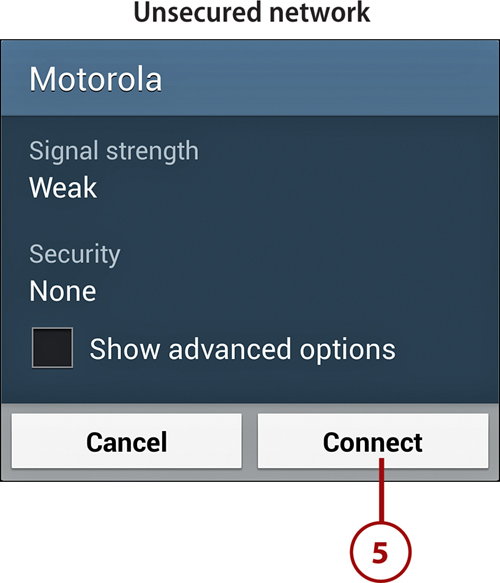
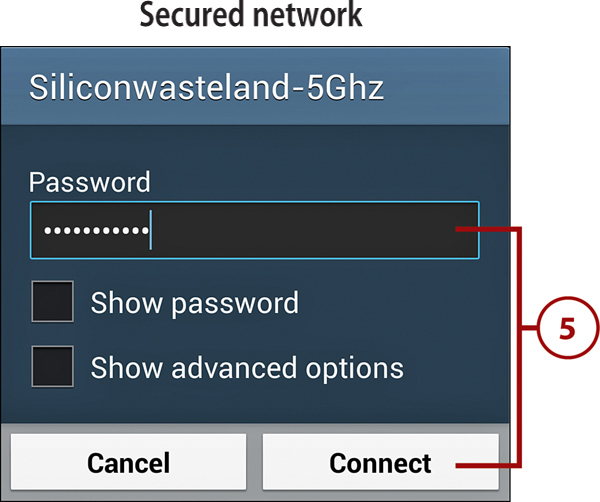
Show Password
When entering a lengthy or complex password, you may find it helpful to tap the Show Password check box. Otherwise, each character in the password is visible only as you type it and is immediately covered by a bullet (•) character.
6. If successful, the Settings screen shows you’re connected to the network. While connected, this information also displays in the Notification panel.
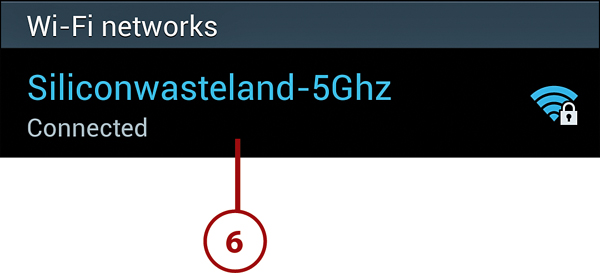
Changing the Default Language
If English isn’t your native language, you can change the phone’s language to another supported language.
1. On the Home screen, tap Apps, followed by Settings.
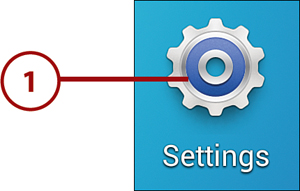
2. Select the My Device tab, scroll down to the Input and Control section, and tap Language and Input.
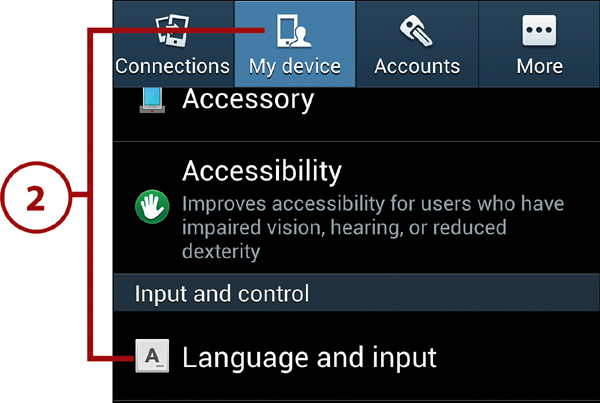
3. Tap Language.

4. Tap the desired language.
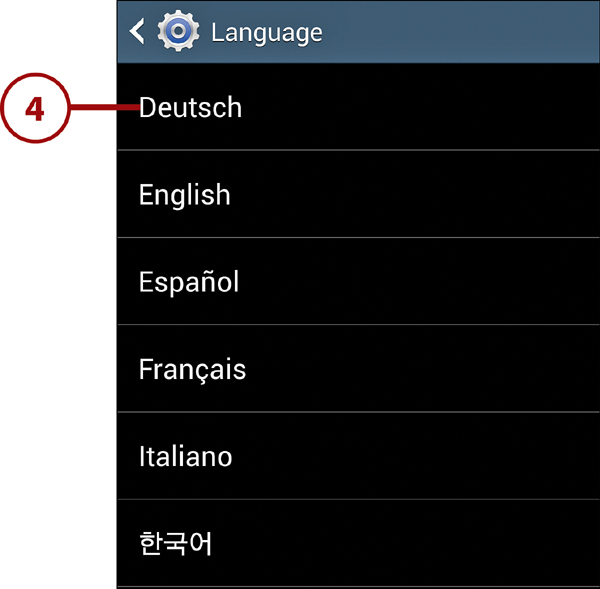
5. Icon names, display text, prompts, dialog boxes, and other text change to reflect the selected language.
